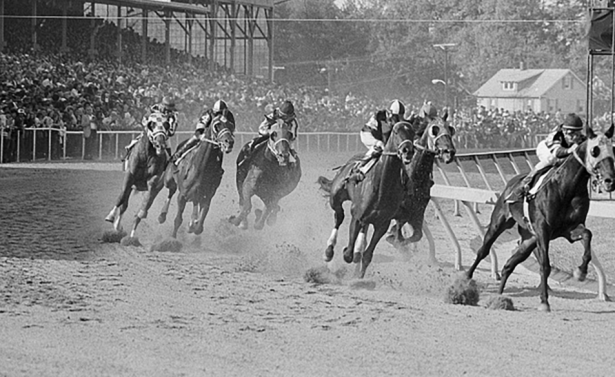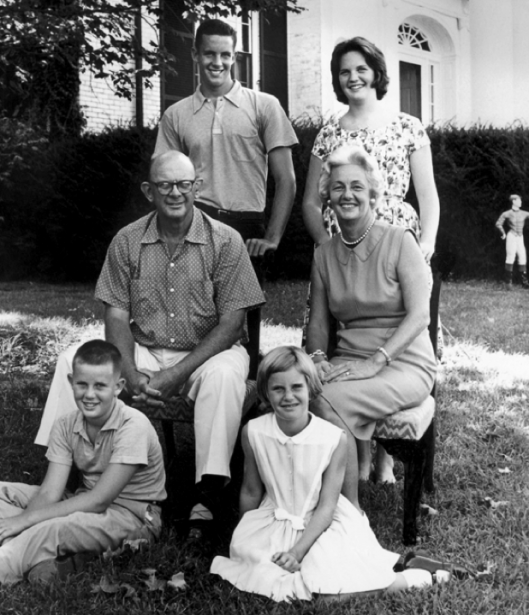Going the distance
With 50 years in the backstretch, the Hancock Lab races forward
April 26, 2023 | Leigh MacMillan

Larry Marnett, PhD, points at an iconic photograph of the American thoroughbred racehorse Secretariat winning the Belmont Stakes and clinching the Triple Crown in 1973. Secretariat, far ahead of the small blurry group of horses behind him, still holds the speed record and largest margin of victory for the track.
“Secretariat won by 31 lengths. That’s where we want cancer discovery research at Vanderbilt to be — out in front by 31 lengths,” says Marnett, University Distinguished Professor of Biochemistry and Chemistry at Vanderbilt.
The worlds of cancer science and thoroughbred racing are bound together at Vanderbilt in the A.B. Hancock Jr. Memorial Laboratory for Cancer Research, which Marnett directs. Waddell Walker Hancock founded the lab in 1972 after her husband, thoroughbred breeder Arthur Boyd “Bull” Hancock Jr., died from pancreatic cancer. The Hancock family owns and runs Claiborne Farm in Paris, Kentucky, where Secretariat stood as a breeding stallion following his Triple Crown win.
Although the family had intended for memorial donations to go to a national cancer foundation, one particularly large donation made Waddell Hancock reconsider that plan, recalls her daughter Dell Hancock.
So, Waddell reached out to family friend F. Tremaine “Josh” Billings, MD, Bull’s college roommate and a Vanderbilt physician, to discuss alternative options.
“Mama really wanted to find out the cause of cancer, and she and Dr. Billings got their heads together and came up with the idea of a research lab,” Dell Hancock says.
“The Hancock Lab was one of the first named laboratories in the country for cancer research,” says Marnett, who holds the Mary Geddes Stahlman Chair in Cancer Research. “It was a very important building block for the Vanderbilt-Ingram Cancer Center.”
Now, as the Hancock Lab celebrates 50 years of success, Vanderbilt is honoring its founder with the establishment of the Waddell Walker Hancock Cancer Discovery Fund. An anonymous donor has jump-started the effort with a $1 million lead gift. The new fund is designed to support the most innovative, high-risk cancer discovery projects, with a focus on basic science research.
“Waddell was so supportive of the lab. She started it; she nurtured it; she got partners to work with it,” says Marnett, who met with Waddell Hancock regularly after he became the Hancock Laboratory director in 1989. “We want to create this endowed fund to seed new science, to seed the next 50 years of cancer discoveries. I think that will honor Waddell very appropriately.”
A philosophy for success
Waddell Walker grew up in Nashville and attended Vanderbilt University. On a visit to Kentucky with her best friend, she met Bull Hancock at the horse races, Dell Hancock shares. They later married, and she joined Bull at Claiborne Farm, which his father started in 1910. The couple had four children.
Claiborne Farm, now in its fourth generation of Hancock family leadership, is a renowned breeder of champion thoroughbred racehorses, with 10 winners of the Kentucky Derby born and raised at Claiborne and six of 13 Triple Crown winners sired there.
When Bull Hancock was asked how to breed winners, he liked to say, “You breed the best to the best and hope for the best,” Marnett says.
That philosophy — of bringing “the best” together — has been foundational to the success of the Hancock Laboratory, and it will guide the selection of projects to be supported by the new fund.
“I’ve tried to use the resources of the Hancock Lab to catalyze multi-investigator science, to bring excellent scientists together to focus on challenging problems,” Marnett says. “That will continue as we select the research to support with the new fund: we’ll choose the best people and the best ideas and hope for the biggest impact on cancer discovery.”
Marnett cites the first Hancock Discovery Grant as an example of the success that has come from the strategy of bringing the best scientists together to tackle something novel.
Following a report in The New England Journal of Medicine that aspirin reduced the risk of fatal colon cancer, Marnett pulled together a group of Vanderbilt researchers to discuss ideas for exploring this novel finding.
“We knew it must have something to do with cyclooxygenase because aspirin inhibits cyclooxygenase, and we wondered if there was something strange about cyclooxygenase in the colon,” Marnett recalls.
One of the scientists, Robert Coffey, MD, had asked if a new Vanderbilt faculty member, Raymond DuBois, MD, PhD, could join the meeting.
“Ray said he had found a gene that seemed to be highly expressed in colon cancer, that he thought might be a cyclooxygenase, but he had no way of demonstrating that,” Marnett says.
Another member of the group, Jason Morrow, MD, had just the right tools, and together, the researchers found that the enzyme cyclooxygenase-2 (COX-2) was elevated in colorectal cancer. The findings led to a series of studies that elucidated the role of inflammatory mediators (COX-2 products) in colon cancer progression, supported the development of COX-2 inhibitors for cancer prevention, and established DuBois as a leader.
“At the time, research in the field of cancer prevention was not as focused on molecular mechanisms of the link between inflammatory mediators and cancer progression,” says DuBois, who is now director of the Hollings Cancer Center at the Medical University of South Carolina.
“The Hancock support was essential to my research program because it allowed me to conduct high-risk research early on that would never have been funded by the National Institutes of Health or other agencies. This kind of support is like ‘manna from heaven’ and is not always easy to obtain.”
DuBois says that he became well known in the field of cancer prevention because of the early work supported by the Hancock Discovery Grant.
“In 2019, I was selected as a member of the National Academy of Medicine, and the citation for that selection was essentially based on the core work done with the help of this discovery grant,” he says.
A fund for ‘risky’ science
The Waddell Walker Hancock Cancer Discovery Fund aims to broaden the support of high-risk, high-reward research at Vanderbilt-Ingram.
“Our goal is to endow the fund to grow and provide support in perpetuity for the best ideas, the wild ideas that may or may not work, but if they work, the payoff is potentially huge,” Marnett says.
Dell Hancock believes her mother would be flattered and humbled to have this fund named for her. Waddell Walker Hancock died in 2005 at age 90.
“She’d probably say, ‘Don’t do it.’ But at the same time, she would be thrilled about it — thrilled that this new initiative will extend what the Hancock Lab has been doing,” Dell Hancock says.
“Mama was a force, and I mean that in a good way. If she set her mind to something, she was going to do it. And she was going to be sure that the lab, like our farm, was a success. The lab became our other sibling in a way.”

After the Vanderbilt-Ingram Cancer Center was established, Waddell Hancock served on the Board of Advisors for many years before passing the baton to her daughter, Dell, who is a current member of the board.
Another board member, Dotty Brotherton, is one of the early contributors to the Waddell Walker Hancock Cancer Discovery Fund.
Brotherton, who resides in Richmond, Virginia, first became acquainted with Vanderbilt-Ingram in 2007 when her husband required complex surgery for a rare thymic carcinoma. As they searched for the best care, Brotherton’s friend Dell Hancock suggested they consider Vanderbilt.
Brotherton was skeptical. “This cancer is so rare that most surgeons have never seen it, or if they have, it has only been once or twice,” Brotherton says. But she agreed to call Bill Putnam, MD, who was chair of Thoracic Surgery, and she learned that he had performed the surgery more than 20 times.
“I said, ‘We’ll be right over,’” she recalls. “Dr. Putnam was able to keep my husband alive through that difficult surgery and give him another good year. And I was so impressed with the level of excellence in every corner of the Medical Center and the personal concern for the patient and the patient’s family.”
Brotherton later joined the Vanderbilt-Ingram Board of Advisors and says the biannual meetings are a highlight for her.
“I come away intellectually challenged and personally inspired by what the doctors and researchers and leaders of the cancer center are doing and the way they are doing it,” she says. “Vanderbilt clearly sits among the best of the best in the nation.”
When she learned about the new fund, Brotherton was enthusiastic to be part of it.
“My personal position in general is to seek out excellence and enhance it,” she says. “I also had the privilege to meet Waddell Hancock a number of times, and she’s a model to me. I am proud to further something that she started.
“I believe that this fund will invite researchers to bring their best visions and imaginations to cancer discovery, and I hope many others will join me to help this initial gift grow.”
It is critical to invest in the type of innovative research that the new fund will support, DuBois says.
“High-risk, high-reward research is usually where the biggest leaps in progress occur in science, and it is not always supported at the level that it should be.”
And although “risky” science will not always succeed, he says, “when it does, it allows us to take a quantum leap forward in the field.”
A quantum leap of 31 lengths, perhaps.
To support the Waddell Walker Hancock Cancer Discovery Fund, visit give.vanderbilthealth.org/WaddellWalkerHancock or contact Beth Jones at b.jones@vumc.org for more information.
